Clusters of Solar Radio Spikes Modulated by Quasi-Periodic Pulsations in a Confined Flare
Abstract
1. Introduction
2. Observations
2.1. The Spectral Observations during the Flares on 21 June 2015
2.2. The Spectral Analysis of the QPSs
2.2.1. Sample I
2.2.2. Sample II
2.2.3. Sample III
2.2.4. Sample IV
2.3. The Statistical Analysis of QPSs
3. Results and Discussion
3.1. Summary of the Observed Features
- (1)
- Each group of QPSs contains many quasi-periodic sub-clusters, and almost all of the QPSs occur synchronously with QPPs. They have the same oscillating period and both of them appear only in the RCP spectrum. Three groups of QPPs are not accompanied by QPPs, but have an in-phase enhanced background.
- (2)
- All the QPSs cover a narrow group bandwidth (150–550 MHz), which grows larger when the QPSs shift to low-frequency band. In contrast, QPPs occur over a broader frequency band, with the largest one covering 0.625 to 2 GHz. Each pulse in QPPs has a cut-off frequency at the low-frequency band, and it has a relatively strong emission around the cut-off frequency.
- (3)
- The duration of each cluster of spikes ranges from 50 to 425 ms in different groups, which increases at low-frequency bands. This duration has a negative exponential decay pattern with the central frequency, with a fitting index of −1.33. When the cluster has a longer lifetime, it would include a larger amount of spikes.
- (4)
- The emission of QPSs is stronger than that of QPPs. The intensity of individual spikes ranges from 10 to 60 sfu by subtracting the continua component, which has a Gaussian-like distribution in both time and frequency. The light curves of QPSs include two components: the intensive scattered emission of spikes and the smooth weak enhanced background. For the emission without spikes at a higher frequency, the light curve also presents a similar periodical enhancement as QPSs.
- (5)
- In one group of QPSs, the duration, bandwidth and intensity of the cluster have a symbiotic mode of evolution. When the emission of QPPs is enhanced, the duration, bandwidth and intensity of QPSs would increase correspondingly. However, the central frequency of the cluster does not show any significant change.
- (6)
- All the QPSs took place in a confined flare, and they appear throughout the entire process. The central frequency of the QPSs shift towards lower frequency bands, resulting in longer duration and broader bandwidth of the cluster. The radio emission presents four main peaks during the flaring process and QPSs would prefer to appear out of the peak time. At the end of the flaring process, the central frequency of QPSs shifts somewhat to a high frequency.
- (7)
- After that, the M2.6 flare took place in the same region, which is accompanied by a fast CME. In this flare, most of the spikes appear in the LCP spectrum, which covers almost the whole frequency range and shows an irregular distribution. In the decay phase of the M2.6 flare, most of the fine structures appear at the low-frequency band with no or weak polarization degree.
3.2. Discussion
4. Summary
Author Contributions
Funding
Institutional Review Board Statement
Informed Consent Statement
Data Availability Statement
Acknowledgments
Conflicts of Interest
References
- Chernov, G.P. Microstructure in continuous emission of type IV meter bursts. Modulation of continuous emission by wave packets of whistlers. Sov. Astron. 1976, 20, 582. [Google Scholar]
- Isliker, H.; Benz, A.O. Catalogue of 1–3 GHz solar flare radio emission. Astron. Astrophys. Suppl. Ser. 1994, 104, 145–160. [Google Scholar]
- Chernov, G.P.; Fu, Q.J.; Lao, D.B.; Hanaoka, Y. Ion-Sound Model of Microwave Spikes with Fast Shocks in the Reconnection Region. Sol. Phys. 2001, 201, 153–180. [Google Scholar] [CrossRef]
- Karlický, M.; Bárta, M.; Jiřička, K.; Mészárosová, H.; Sawant, H.S.; Fernandes, F.C.R.; Cecatto, J.R. Radio bursts with rapid frequency variations—Lace bursts. Astron. Astrophys. 2001, 375, 638–642. [Google Scholar] [CrossRef]
- Fu, Q.J.; Yan, Y.H.; Liu, Y.Y.; Wang, M.; Wang, S.J. A New Catalogue of Fine Structures Superimposed on Solar Microwave Bursts. Chin. J. Astron. Astrophys. 2004, 4, 176–188. [Google Scholar] [CrossRef]
- Liu, Y.Y.; Fu, Q.J.; Yan, Y.H.; Tan, C.M. New results obtained from the solar radio spectrometer in decimeter wavelength with super-high temporal resolution. Publ. Natl. Astron. Obs. China 2006, 3, 119–127. [Google Scholar]
- Huang, J.; Yan, Y.; Liu, Y. An analysis of solar radio burst events on 1 December 2004. Adv. Space Res. 2007, 39, 1439–1444. [Google Scholar] [CrossRef]
- Kontar, E.P.; Yu, S.; Kuznetsov, A.A.; Emslie, A.G.; Alcock, B.; Jeffrey, N.L.S.; Melnik, V.N.; Bian, N.H.; Subramanian, P. Imaging spectroscopy of solar radio burst fine structures. Nat. Commun. 2017, 8, 1515. [Google Scholar] [CrossRef]
- Karlický, M.; Yasnov, L.V. Determination of Plasma Parameters in Radio Sources of Solar Zebra-patterns Based on Relations between the Zebra-stripe Frequencies and Gyro-harmonic Numbers. Astrophys. J. 2018, 867, 28. [Google Scholar] [CrossRef]
- Kuznetsov, A.A.; Kontar, E.P. First imaging spectroscopy observations of solar drift pair bursts. Astron. Astrophys. 2019, 631, L7. [Google Scholar] [CrossRef]
- Chen, X.; Kontar, E.P.; Chrysaphi, N.; Jeffrey, N.L.S.; Gordovskyy, M.; Yan, Y.; Tan, B. Subsecond Time Evolution of Type III Solar Radio Burst Sources at Fundamental and Harmonic Frequencies. Astrophys. J. 2020, 905, 43. [Google Scholar] [CrossRef]
- Reid, H.A.S.; Kontar, E.P. Fine structure of type III solar radio bursts from Langmuir wave motion in turbulent plasma. Nat. Astron. 2021, 5, 796–804. [Google Scholar] [CrossRef]
- Bastian, T.S.; Benz, A.O.; Gary, D.E. Radio Emission from Solar Flares. Annu. Rev. Astron. Astrophys. 1998, 36, 131–188. [Google Scholar] [CrossRef]
- Gary, D.E.; Keller, C.U. (Eds.) Solar and Space Weather Radiophysics–Current Status and Future Developments; Astrophysics and Space Science Library, Kluwer Academic Publishers: Dordrecht, The Netherlands, 2004; Volume 314. [Google Scholar]
- Aschwanden, M.J. Physics of the Solar Corona: An Introduction; Praxis Publishing Ltd.: Chichester, UK; Springer: Berlin, Germany, 2004. [Google Scholar]
- Benz, A.O. Radio Spikes and the Fragmentation of Flare Energy Release. Sol. Phys. 1985, 96, 357–370. [Google Scholar] [CrossRef]
- Guedel, M.; Benz, A.O. Time profiles of solar radio spikes. Astron. Astrophys. 1990, 231, 202–212. [Google Scholar]
- Altyntsev, A.T.; Grechnev, V.V.; Zubkova, G.N.; Kardapolova, N.N.; Lesovoi, S.V.; Rosenraukh, Y.M.; Treskov, T.A. Observations of solar microwave spikes with high spatial resolution at the SSRT: First results. Astron. Astrophys. 1995, 303, 249. [Google Scholar]
- Zlobec, P.; Karlický, M. Narrowband dm-SPIKES Observed during the 15 June 1991 Flare. Sol. Phys. 1998, 182, 477–496. [Google Scholar] [CrossRef]
- Ma, Y.; Xie, R.; Zheng, X.; Huang, G. Observations and analyses of solar radio metric narrow-band fast pulsation phenomena. Sol. Phys. 2003, 214, 353–360. [Google Scholar] [CrossRef]
- Rozhansky, I.V.; Fleishman, G.D.; Huang, G.L. Millisecond Microwave Spikes: Statistical Study and Application for Plasma Diagnostics. Astrophys. J. 2008, 681, 1688–1697. [Google Scholar] [CrossRef][Green Version]
- Melnik, V.N.; Shevchuk, N.V.; Konovalenko, A.A.; Rucker, H.O.; Dorovskyy, V.V.; Poedts, S.; Lecacheux, A. Solar Decameter Spikes. Sol. Phys. 2014, 289, 1701–1714. [Google Scholar] [CrossRef]
- Chen, B.; Bastian, T.S.; Shen, C.; Gary, D.E.; Krucker, S.; Glesener, L. Particle acceleration by a solar flare termination shock. Science 2015, 350, 1238–1242. [Google Scholar] [CrossRef]
- Clarkson, D.L.; Kontar, E.P.; Gordovskyy, M.; Chrysaphi, N.; Vilmer, N. First Frequency-time-resolved Imaging Spectroscopy Observations of Solar Radio Spikes. Astrophys. J. Lett. 2021, 917, L32. [Google Scholar] [CrossRef]
- Benz, A.O.; Su, H.; Magun, A.; Stehling, W. Millisecond microwave spikes at 8 GHz during solar flares. Astron. Astrophys. Suppl. Ser. 1992, 93, 539–544. [Google Scholar]
- Csillaghy, A.; Benz, A.O. The bandwidth of millisecond radio spikes in solar flares. Astron. Astrophys. 1993, 274, 487. [Google Scholar]
- Fleishman, G.D.; Gary, D.E.; Nita, G.M. Decimetric Spike Bursts versus Microwave Continuum. Astrophys. J. 2003, 593, 571–580. [Google Scholar] [CrossRef]
- Armatas, S.; Bouratzis, C.; Hillaris, A.; Alissandrakis, C.E.; Preka-Papadema, P.; Moussas, X.; Mitsakou, E.; Tsitsipis, P.; Kontogeorgos, A. Detection of spike-like structures near the front of type-II bursts. Astron. Astrophys. 2019, 624, A76. [Google Scholar] [CrossRef]
- Guedel, M. Solar radio spikes—Radiation at harmonics S = 2–6. Astron. Astrophys. 1990, 239, L1–L4. [Google Scholar]
- Krucker, S.; Benz, A.O. The frequency ratio of bands of microwave spikes during solar flares. Astron. Astrophys. 1994, 285, 1038–1046. [Google Scholar]
- Feng, S.W. The properties of solar radio spikes with harmonics and the associated EUV brightenings. Astrophys. Space Sci. 2019, 364, 4. [Google Scholar] [CrossRef]
- Luo, Y.; Chen, B.; Yu, S.; Bastian, T.S.; Krucker, S. Radio Spectral Imaging of an M8.4 Eruptive Solar Flare: Possible Evidence of a Termination Shock. Astrophys. J. 2021, 911, 4. [Google Scholar] [CrossRef]
- Battaglia, M.; Sharma, R.; Luo, Y.; Chen, B.; Yu, S.; Krucker, S. Multiple Electron Acceleration Instances during a Series of Solar Microflares Observed Simultaneously at X-Rays and Microwaves. Astrophys. J. 2021, 922, 134. [Google Scholar] [CrossRef]
- Tan, B.l.; Cheng, J.; Tan, C.m.; Kou, H.x. Scaling-laws of Radio Spike Bursts and Their Constraints on New Solar Radio Telescopestwo. Chin. Astron. Astrophys. 2019, 43, 59–74. [Google Scholar] [CrossRef]
- Benz, A.O.; Saint-Hilaire, P.; Vilmer, N. Location of narrowband spikes in solar flares. Astron. Astrophys. 2002, 383, 678–684. [Google Scholar] [CrossRef]
- Shevchuk, N.V.; Melnik, V.N.; Poedts, S.; Dorovskyy, V.V.; Magdalenic, J.; Konovalenko, A.A.; Brazhenko, A.I.; Briand, C.; Frantsuzenko, A.V.; Rucker, H.O.; et al. The Storm of Decameter Spikes During the Event of 14 June 2012. Sol. Phys. 2016, 291, 211–228. [Google Scholar] [CrossRef]
- Bouratzis, C.; Hillaris, A.; Alissandrakis, C.E.; Preka-Papadema, P.; Moussas, X.; Caroubalos, C.; Tsitsipis, P.; Kontogeorgos, A. High resolution observations with Artemis-IV and the NRH. I. Type IV associated narrow-band bursts. Astron. Astrophys. 2016, 586, A29. [Google Scholar] [CrossRef]
- Benz, A.O.; Jaeggi, M.; Zlobec, P. Fine structure near the starting frequency of solar type III radio bursts. Astron. Astrophys. 1982, 109, 305–313. [Google Scholar]
- Chen, B.; Shen, C.; Reeves, K.K.; Guo, F.; Yu, S. Radio Spectroscopic Imaging of a Solar Flare Termination Shock: Split-band Feature as Evidence for Shock Compression. Astrophys. J. 2019, 884, 63. [Google Scholar] [CrossRef]
- Khan, J.I.; Aurass, H. Observations of the coronal dynamics associated with solar radio spike burst emission. Astron. Astrophys. 2006, 457, 319–328. [Google Scholar] [CrossRef]
- Battaglia, M.; Benz, A.O. Do solar decimetric spikes originate in coronal X-ray sources? Astron. Astrophys. 2009, 499, L33–L36. [Google Scholar] [CrossRef]
- Brown, R.L.; Crane, P.C. On the rapidly variable circular polarization of HR 1099 at radio frequencies. Astron. J. 1978, 83, 1504–1509. [Google Scholar] [CrossRef]
- Melrose, D.B.; Dulk, G.A. Electron-cyclotron masers as the source of certain solar and stellar radio bursts. Astrophys. J. 1982, 259, 844–858. [Google Scholar] [CrossRef]
- Robinson, P.A. Electron Cyclotron Maser Emission in Solar Microwave Spike Bursts. Sol. Phys. 1991, 134, 299–314. [Google Scholar] [CrossRef]
- Karlický, M.; Benáček, J.; Rybák, J. Narrowband Spikes Observed during the 2013 November 7 Flare. Astrophys. J. 2021, 910, 108. [Google Scholar] [CrossRef]
- Stepanov, A.V.; Kliem, B.; Krüger, A.; Hildebrandt, J.; Garaimov, V.I. Second-Harmonic Plasma Radiation of Magnetically Trapped Electrons in Stellar Coronae. Astrophys. J. 1999, 524, 961–973. [Google Scholar] [CrossRef]
- Bárta, M.; Karlický, M. Turbulent plasma model of the narrowband dm-spikes. Astron. Astrophys. 2001, 379, 1045–1051. [Google Scholar] [CrossRef][Green Version]
- Wu, D.J.; Huang, J.; Tang, J.F.; Yan, Y.H. Solar Microwave Drifting Spikes and Solitary Kinetic Alfvén Waves. Astrophys. J. 2007, 665, L171–L174. [Google Scholar] [CrossRef]
- Yan, Y.; Chen, Z.; Wang, W.; Liu, F.; Geng, L.; Chen, L.; Tan, C.; Chen, X.; Su, C.; Tan, B. Mingantu Spectral Radioheliograph for Solar and Space Weather Studies. Front. Astron. Space Sci. 2021, 8, 20. [Google Scholar] [CrossRef]
- Yan, Y.; Tan, C.; Xu, L.; Ji, H.; Fu, Q.; Song, G. Nonlinear calibration and data processing of the solar radio burst. Sci. China A Math. 2002, 45, 89–96. [Google Scholar] [CrossRef]
- Tan, C.; Yan, Y.; Tan, B.; Xu, G. Calibration of the solar radio spectrometer. Sci. China Phys. Mech. Astron. 2009, 52, 1760–1764. [Google Scholar] [CrossRef]
- Tan, C.; Yan, Y.; Tan, B.; Fu, Q.; Liu, Y.; Xu, G. Study of Calibration of Solar Radio Spectrometers and the Quiet-Sun Radio Emission. Astrophys. J. 2015, 808, 61. [Google Scholar] [CrossRef]
- Nakariakov, V.M.; Melnikov, V.F. Quasi-Periodic Pulsations in Solar Flares. Space Sci. Rev. 2009, 149, 119–151. [Google Scholar] [CrossRef]
- Tan, B.; Zhang, Y.; Tan, C.; Liu, Y. Microwave Quasi-Periodic Pulsations in Multi-timescales Associated with a Solar Flare/CME Event. Astrophys. J. 2010, 723, 25–39. [Google Scholar] [CrossRef][Green Version]
- Tan, B.; Tan, C. Microwave Quasi-periodic Pulsation with Millisecond Bursts in a Solar Flare on 2011 August 9. Astrophys. J. 2012, 749, 28. [Google Scholar] [CrossRef]
- Chen, X.; Yan, Y.; Tan, B.; Huang, J.; Wang, W.; Chen, L.; Zhang, Y.; Tan, C.; Liu, D.; Masuda, S. Quasi-periodic Pulsations before and during a Solar Flare in AR 12242. Astrophys. J. 2019, 878, 78. [Google Scholar] [CrossRef]
- Li, D.; Feng, S.; Su, W.; Huang, Y. Preflare very long-periodic pulsations observed in Hα emission before the onset of a solar flare. Astron. Astrophys. 2020, 639, L5. [Google Scholar] [CrossRef]
- Hong, Z.; Li, D.; Zhang, M.; Tan, C.; Ma, S.; Ji, H. Multi-Wavelength Observations of Quasi-Periodic Pulsations in a Solar Flare. Sol. Phys. 2021, 296, 171. [Google Scholar] [CrossRef]
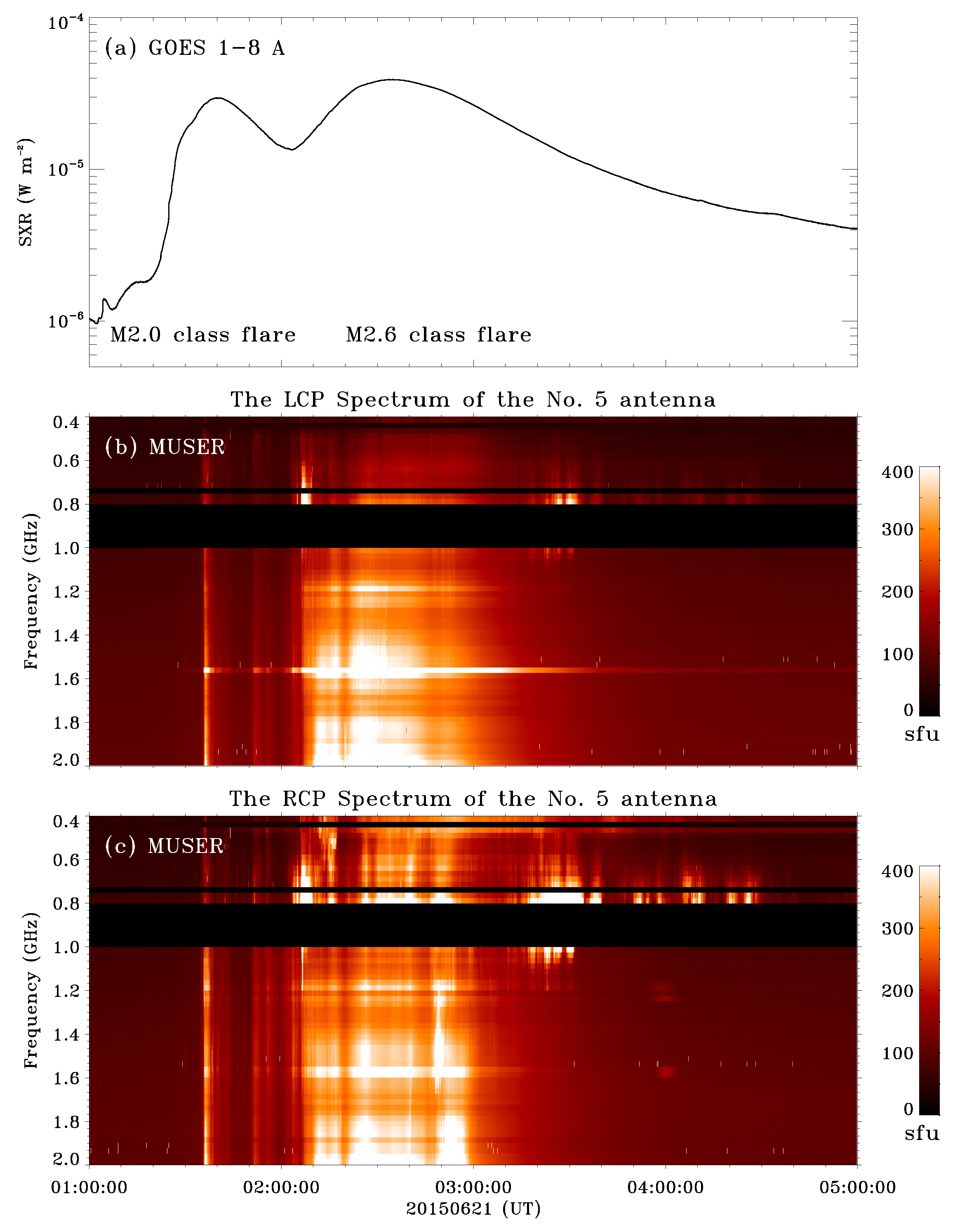
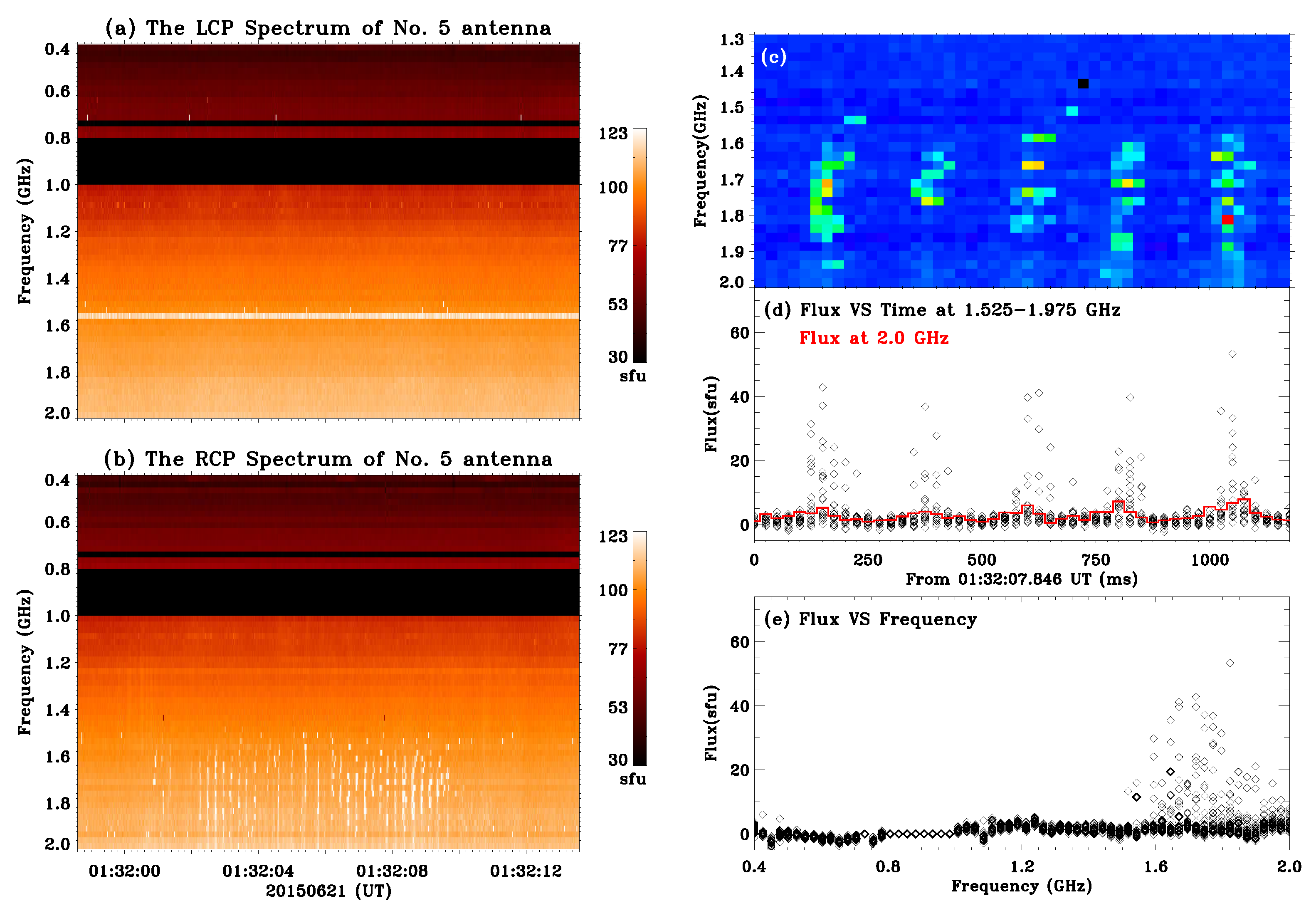
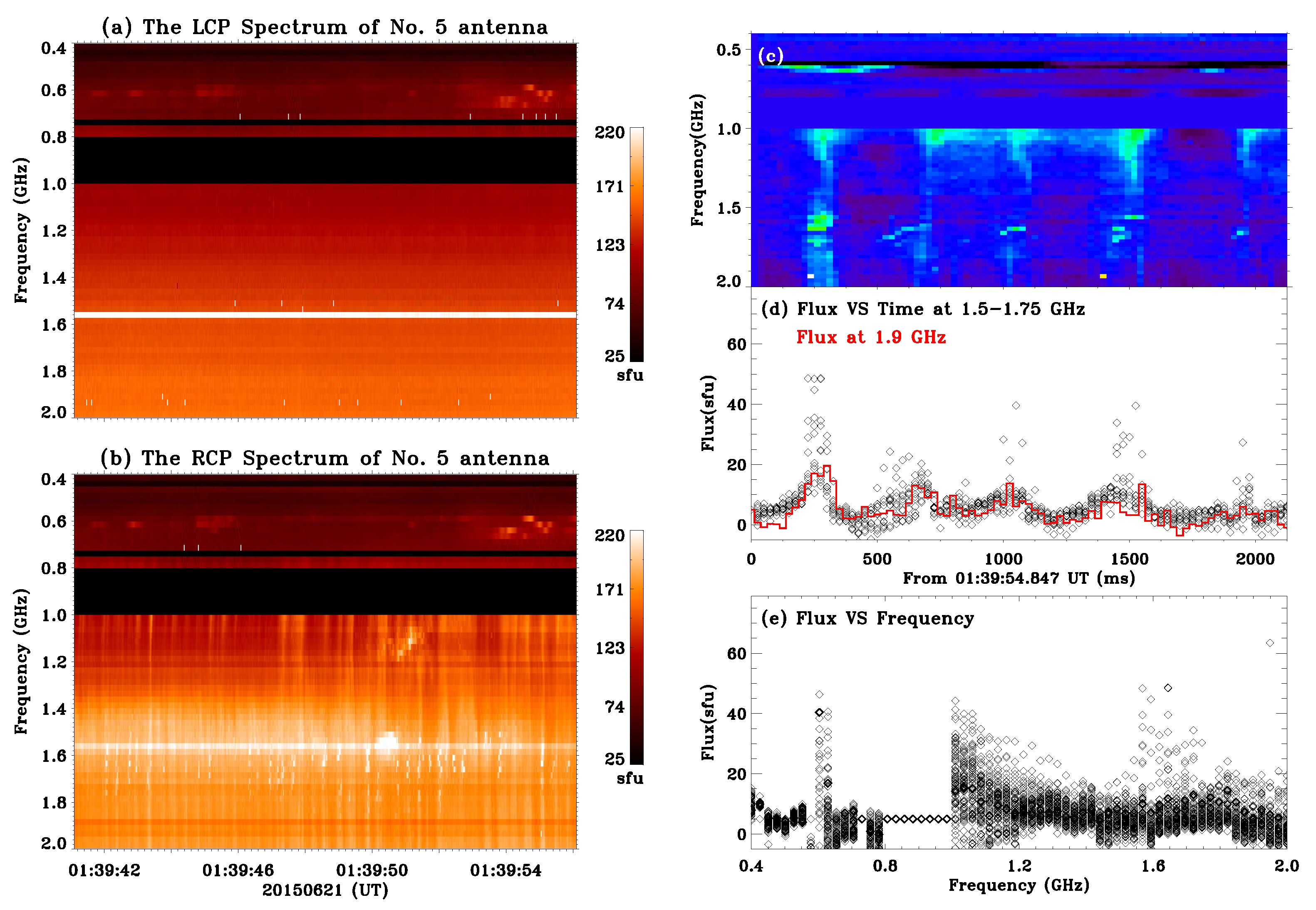
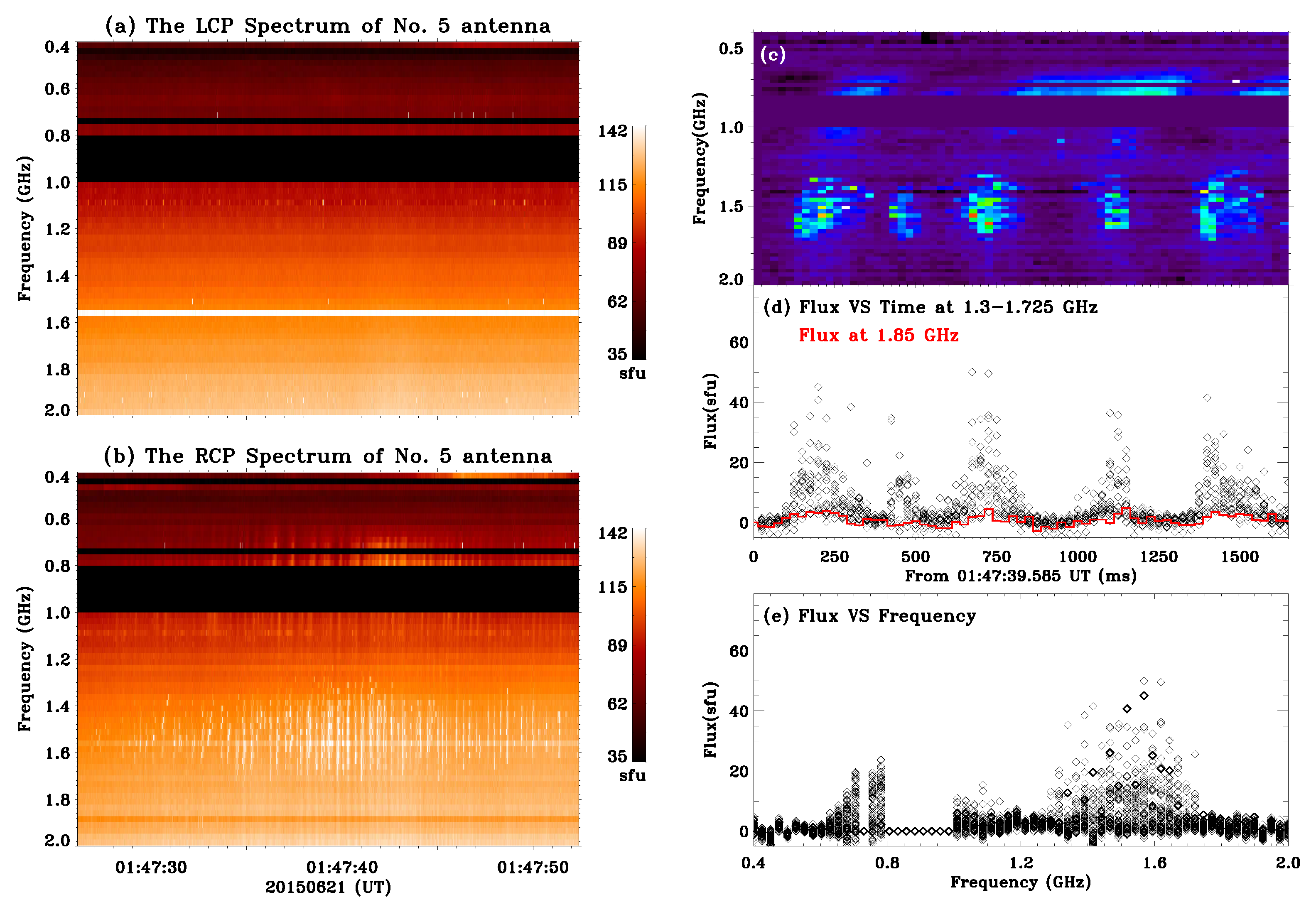
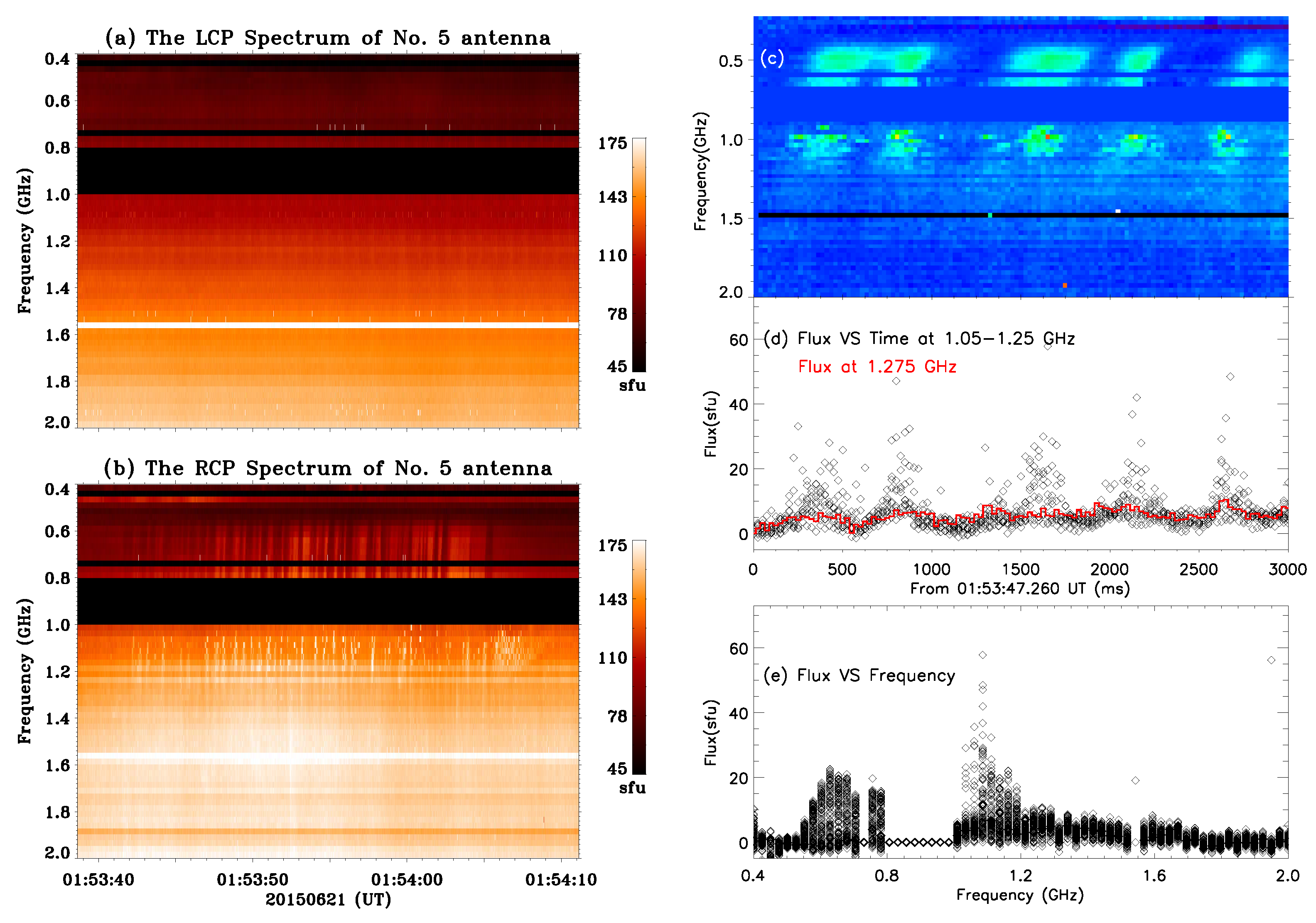

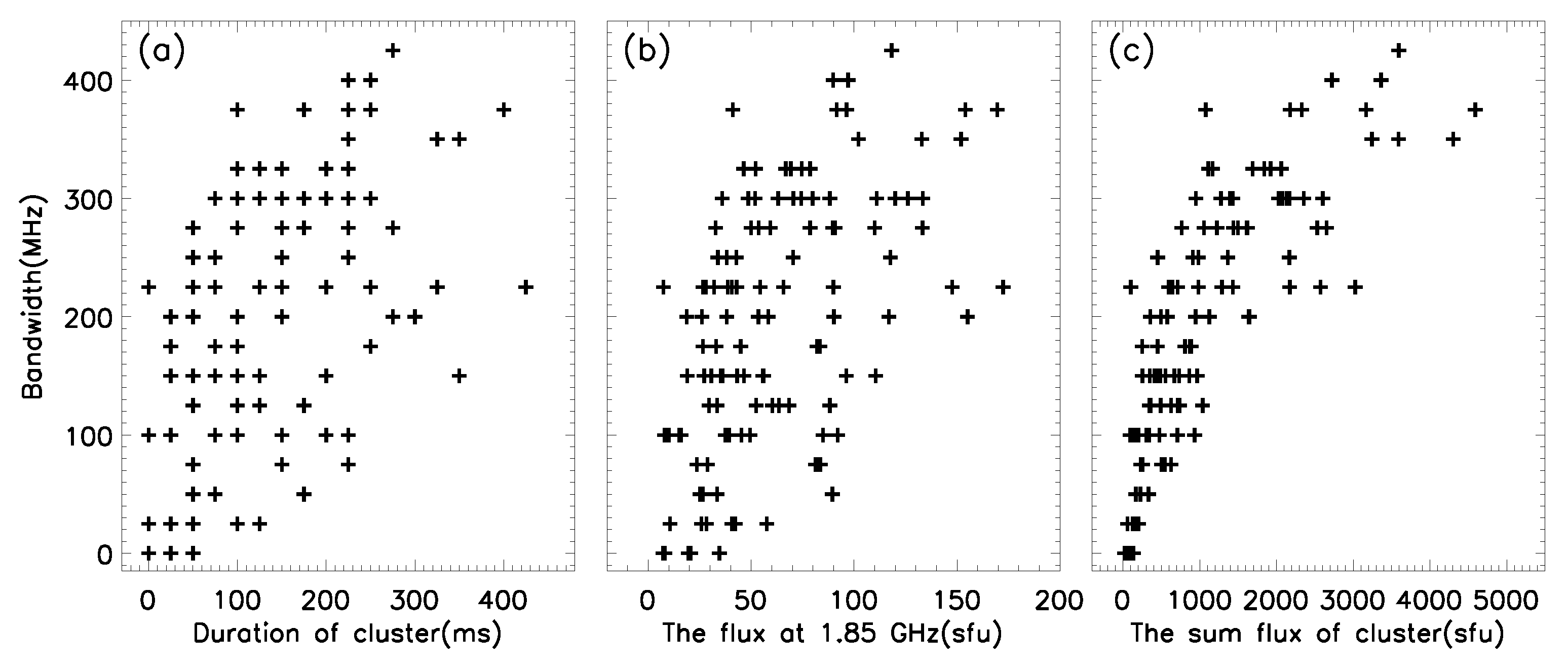
Publisher’s Note: MDPI stays neutral with regard to jurisdictional claims in published maps and institutional affiliations. |
© 2022 by the authors. Licensee MDPI, Basel, Switzerland. This article is an open access article distributed under the terms and conditions of the Creative Commons Attribution (CC BY) license (https://creativecommons.org/licenses/by/4.0/).
Share and Cite
Huang, J.; Tan, C.; Chen, X.; Tan, B.; Yan, Y.; Zhang, Y.; Ma, S.; Zhou, Z.; Zhang, M.; Wang, W.; et al. Clusters of Solar Radio Spikes Modulated by Quasi-Periodic Pulsations in a Confined Flare. Universe 2022, 8, 348. https://doi.org/10.3390/universe8070348
Huang J, Tan C, Chen X, Tan B, Yan Y, Zhang Y, Ma S, Zhou Z, Zhang M, Wang W, et al. Clusters of Solar Radio Spikes Modulated by Quasi-Periodic Pulsations in a Confined Flare. Universe. 2022; 8(7):348. https://doi.org/10.3390/universe8070348
Chicago/Turabian StyleHuang, Jing, Chengming Tan, Xingyao Chen, Baolin Tan, Yihua Yan, Yin Zhang, Suli Ma, Zhichao Zhou, Minghui Zhang, Wei Wang, and et al. 2022. "Clusters of Solar Radio Spikes Modulated by Quasi-Periodic Pulsations in a Confined Flare" Universe 8, no. 7: 348. https://doi.org/10.3390/universe8070348
APA StyleHuang, J., Tan, C., Chen, X., Tan, B., Yan, Y., Zhang, Y., Ma, S., Zhou, Z., Zhang, M., Wang, W., & Chen, L. (2022). Clusters of Solar Radio Spikes Modulated by Quasi-Periodic Pulsations in a Confined Flare. Universe, 8(7), 348. https://doi.org/10.3390/universe8070348






